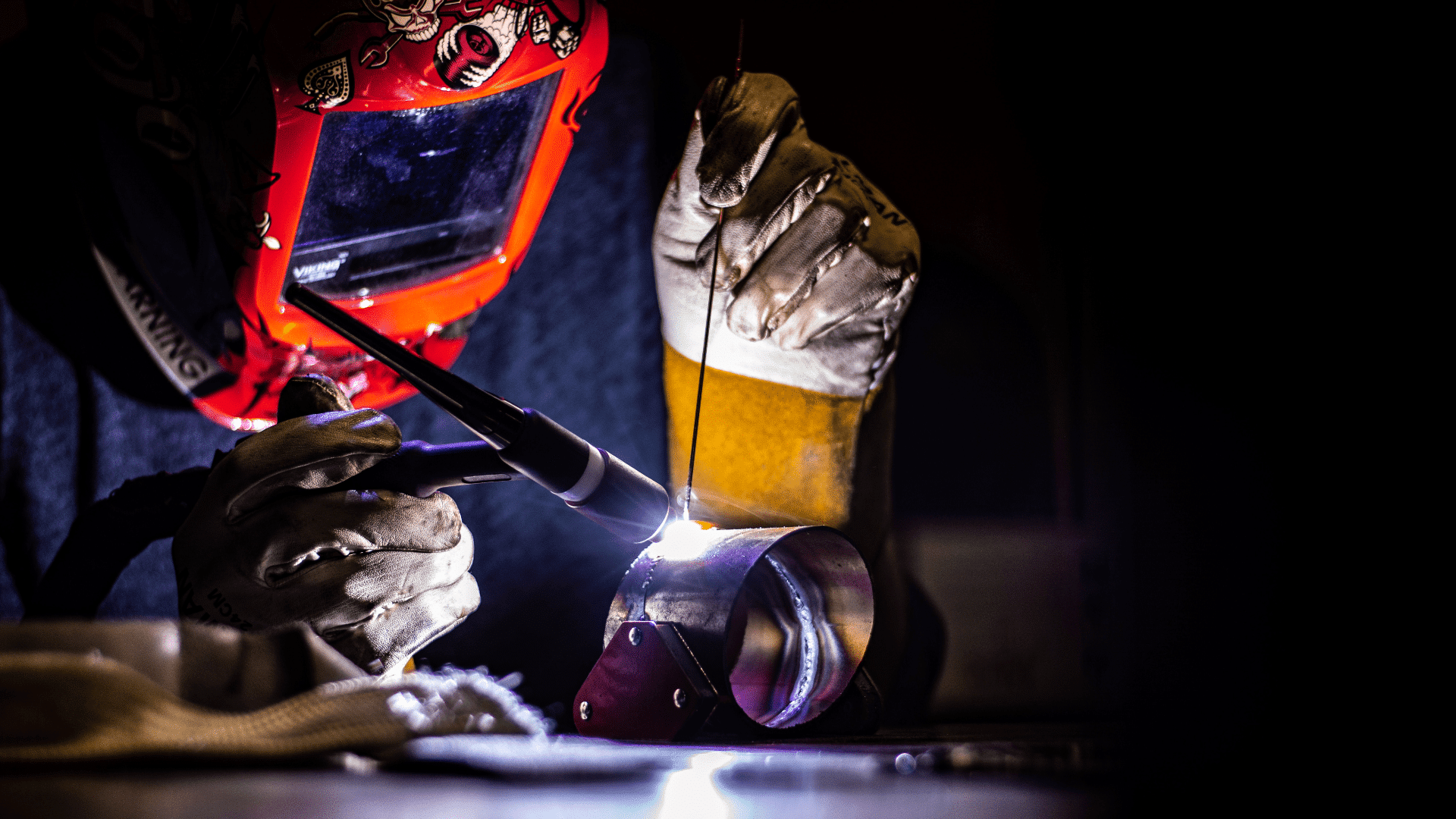TIG Welding, a craft as much as it is a skill, demands precision and a keen eye for detail. In the hands of a master, it can produce strong, clean, and visually stunning welds. But like any craft, it comes with its own set of challenges and common issues that can affect the quality of the final product.
In this guide, we’re diving deep into the world of TIG Welding, uncovering the common problems that can occur and, more importantly, how to overcome them. Whether you’re just starting out or have been welding for years, understanding these issues is key to improving your technique and ensuring every weld is of the highest quality. So, let’s get started on this journey together, exploring the intricacies of TIG Welding and learning how to achieve the best results every time.
In this guide:
Huge Savings on TIG Welders!
Check out our fantastic range of TIG welding machines!

Navigating Common Quality Issues in TIG Welding
Even the most seasoned welders can encounter challenges that, if not addressed, can compromise the integrity and appearance of the weld. We’re going to explore some of the most common quality issues in TIG Welding, delve into what causes them, and arm you with strategies to prevent and overcome these challenges. So, let’s dive in and get to the bottom of these pesky problems, ensuring your welds are nothing short of perfection.
| Quality Issue | Description | Causes | Prevention Strategies |
|---|---|---|---|
| Porosity | Tiny holes or bubbles in the weld, weakening the structure and appearance. | Contamination, inadequate shielding gas, moisture. | Clean materials thoroughly, ensure proper gas flow and coverage, pre-weld heating to remove moisture. |
| Cracking | Fractures or splits in the weld, compromising its strength. | Rapid cooling, material thickness mismatch, improper filler material. | Preheat thicker materials, choose the correct filler material, control cooling rate. |
| Crater Formation | Small pits at the end of a weld, affecting the weld’s appearance and strength. | Abrupt termination of the welding arc, insufficient filler material at weld’s end, lack of backfilling. | Gradually reduce welding current to finish, ensure adequate filler material, practice backfilling. |
| Incomplete Fusion | Lack of proper bonding between weld and base materials. | Incorrect welding angle, insufficient heat, improper filler material use. | Use the correct welding angle, adjust heat input, ensure proper filler material application. |
| Tungsten Inclusions | Bits of tungsten electrode trapped in the weld. | Touching the tungsten to the weld pool, using a damaged electrode. | Keep the electrode away from the weld pool, regularly check and replace damaged electrodes. |
| Distortion | Warping or deformation of the welded material. | Excessive heat input, uneven welding, improper clamping. | Control heat input, weld evenly from side to side, use proper clamping techniques. |
| Lack of Penetration | Weld does not fully penetrate the workpieces, leading to a weak joint. | Insufficient heat, incorrect torch angle, too fast welding speed. | Increase heat input, adjust torch angle, slow down welding speed. |
| Oxidation and Discoloration | Unwanted color change or oxide formation on the weld. | Inadequate shielding gas, contamination, excessive heat. | Ensure proper shielding gas coverage, clean materials, control heat input. |
| Electrode Deterioration | Wear and tear on the tungsten electrode, affecting weld quality. | Using an incorrect current type, improper electrode grinding, poor storage. | Match current type and electrode, grind electrode properly, store electrodes correctly. |
Porosity: Bubbles and Holes
In the world of TIG welding, achieving a flawless finish is the ultimate goal. However, porosity, appearing as small bubbles or holes in the weld, can be a significant roadblock. Porosity refers to the presence of tiny cavities or bubbles in the weld, caused by trapped gas. These imperfections can weaken the weld and affect its appearance. This common issue not only affects the aesthetic of the weld but also its structural integrity. In this section, we will explore the causes of porosity and provide practical strategies to prevent it.
Common Causes
Before diving into welding, it’s crucial to understand what might lead to porosity, so you can take proactive steps to avoid it. The most common causes of porosity in TIG welds are:
- Contamination: Dirt, oil, or other impurities on the workpiece or filler material can introduce gases into the weld pool, leading to porosity.
- Moisture: Moisture from the atmosphere or materials can break down into hydrogen gas during welding, becoming trapped and causing porosity.
- Incorrect Gas Flow: Insufficient or turbulent shielding gas flow can expose the weld pool to air, resulting in porosity.
Prevention Strategies
Preventing porosity is all about control – controlling your materials, your environment, and your equipment.
- Ensure Cleanliness: Thoroughly clean the workpiece and filler material before welding to remove any contaminants.
- Control Moisture: Store materials in a dry environment and preheat them if necessary to eliminate moisture.
- Optimize Gas Flow: Ensure that the shielding gas flow is set correctly and that the equipment is in good condition to provide consistent protection.
Detection of Porosity
- Visual Inspection: Often, porosity can be detected through a careful visual inspection of the weld surface. Look for small holes or irregularities on the surface.
- Non-Destructive Testing (NDT): Techniques such as ultrasonic testing or radiography can be used to detect porosity beneath the surface of the weld.
Tackling porosity requires a proactive approach, focusing on cleanliness, moisture control, and proper equipment usage. By addressing these key areas and being vigilant in detecting potential porosity, welders can significantly reduce the occurrence of porosity, paving the way for stronger, more visually appealing welds.
Cracking: Preventing Fractures
Cracking refers to the fractures or splits that can appear in or around the weld, often resulting from stress and improper welding conditions. In TIG welding, the appearance of cracks is a clear sign that something has gone awry. Cracking compromises the integrity of the weld and can lead to failure in the final product. In this section, we will explore the different types of cracks, understand why they occur, and equip ourselves with strategies to prevent them.
Common Causes
To prevent cracking, it’s essential to understand the factors that contribute to its occurrence.
- Rapid Cooling: When the weld cools too quickly, it can lead to cracking.
- Material Thickness Mismatch: Welding materials of different thicknesses can create stress, resulting in cracks.
- Improper Filler Material: Using the wrong filler material can lead to incompatibility and cracking.
Prevention Strategies
Cracking can be prevented with careful attention to the welding process and material preparation.
- Control Cooling Rate: Ensure the weld cools at an appropriate rate to prevent stress and cracking.
- Match Material Thickness: When possible, use materials of the same thickness to reduce stress on the weld.
- Choose the Correct Filler Material: Select a filler material that is compatible with the base materials to prevent cracking.
Detection of Cracking
- Visual Inspection: Many cracks are visible to the naked eye or can be detected using a magnifying glass during a thorough inspection of the weld.
- Dye Penetrant Inspection: Dye penetrant is a non-destructive testing method that can be used to reveal cracks on the surface of the material.
Cracking is a serious issue in TIG welding, but with the right knowledge and attention to detail, it can be prevented. By understanding the causes of cracking and implementing effective prevention strategies, welders can produce strong, crack-free welds.
Crater Formation: Addressing and Preventing Welding Pits
Crater formation, or the occurrence of small pits at the end of a weld, is a common issue in TIG welding that can compromise both the aesthetic and structural integrity of the weld. These craters are formed when the welding arc is extinguished too quickly, leaving a depression or pit in the weld pool. In this section, we will delve into the causes of crater formation and discuss strategies to prevent and address this issue.
Common Causes
Understanding the factors that contribute to crater formation is crucial for preventing this issue.
- Abrupt Termination of the Welding Arc: Quickly extinguishing the welding arc can cause the molten pool to solidify rapidly, resulting in a crater.
- Insufficient Filler Material at the Weld’s End: Failing to add enough filler material at the end of the weld can leave a depression as the weld pool solidifies.
- Lack of Backfilling: Not backfilling, or moving the torch back over the crater to fill it in, can leave a pit in the weld.
Prevention Strategies
Employing the right techniques and practices is key to preventing crater formation.
- Gradual Arc Termination: Instead of abruptly extinguishing the arc, gradually reduce the current to allow the weld pool to solidify more slowly and evenly.
- Ensure Adequate Filler Material: Make sure to add sufficient filler material at the end of the weld to fill in any potential craters.
- Practice Backfilling: After reaching the end of the weld, move the torch back over the crater area to fill in any depression and create a smooth, even surface.
Detection of Craters
- Visual Inspection: Craters are typically visible to the naked eye, appearing as small pits or depressions at the end of a weld.
- Use of Precision Measuring Tools: Tools such as calipers can be used to measure the depth and width of the crater, providing more detailed information about its size and shape.
Addressing crater formation is essential for ensuring the quality and integrity of TIG welds. By understanding the causes of craters and implementing effective prevention strategies, welders can produce smooth, pit-free welds that meet both aesthetic and structural standards.
Incomplete Fusion: Ensuring Strong Bonds
Achieving a strong, consistent bond between the base materials is a critical aspect of TIG welding. Incomplete fusion, however, can disrupt this bond, leading to weak points in the weld. Incomplete fusion occurs when the weld metal fails to adequately merge with the base materials, resulting in a lack of cohesion and potential weak points. In this section, we will delve into the causes of incomplete fusion and discuss strategies to ensure a fully bonded, robust weld.
Common Causes
Recognizing the factors that contribute to incomplete fusion is the first step in preventing this issue.
- Incorrect Welding Angle: Welding at an improper angle can prevent the weld metal from fully bonding with the base materials.
- Insufficient Heat: Without adequate heat, the weld metal may not fully melt and merge with the base materials.
- Improper Filler Material Use: Using filler material incorrectly can lead to gaps and lack of fusion in the weld.
Prevention Strategies
Preventing incomplete fusion requires a combination of proper technique and equipment settings.
- Use the Correct Welding Angle: Ensure that you are welding at the appropriate angle to facilitate full fusion with the base materials.
- Adjust Heat Input: Ensure that your heat settings are high enough to fully melt the weld metal and allow it to merge with the base materials.
- Properly Apply Filler Material: If using filler material, apply it correctly to avoid gaps and ensure a strong, cohesive weld.
Detection of Incomplete Fusion
- Visual Inspection: Some instances of incomplete fusion can be detected through a careful examination of the weld, looking for areas where the weld metal appears not to have fully bonded with the base materials.
- Non-Destructive Testing (NDT): Techniques such as ultrasonic testing can help identify areas of incomplete fusion that may not be visible to the naked eye.
Incomplete fusion can be a subtle yet significant issue in TIG welding, leading to weakened welds. By understanding the causes and implementing effective prevention strategies, welders can ensure a strong bond and a robust weld, every time.
Tungsten Inclusions: Keeping Your Weld Clean
Tungsten inclusions are a common yet avoidable issue in TIG welding, where particles of the tungsten electrode become embedded in the weld. Tungsten inclusions occur when particles from the tungsten electrode break off and become embedded in the weld, creating impurities and potential weak points.This not only affects the aesthetics of the weld but also its structural integrity. In this section, we will explore the causes of tungsten inclusions and discuss strategies to prevent them, ensuring a clean and strong weld.
Common Causes
Understanding what leads to tungsten inclusions is crucial for preventing them.
- Touching the Tungsten to the Weld Pool: Accidentally dipping the tungsten electrode into the weld pool can cause particles to break off and become trapped.
- Using a Damaged Electrode: Welding with a damaged or contaminated tungsten electrode increases the risk of inclusions.
Prevention Strategies
Preventing tungsten inclusions is all about maintaining control and ensuring your equipment is in top condition.
- Maintain a Steady Hand: Be mindful of your technique to avoid accidentally dipping the tungsten electrode into the weld pool.
- Regularly Check and Replace Electrodes: Inspect your tungsten electrode regularly for signs of damage or contamination and replace it as necessary.
Detection of Tungsten Inclusions
- Visual Inspection: Tungsten inclusions can often be seen as small, dark spots within the weld or on its surface.
- Non-Destructive Testing (NDT): Techniques such as ultrasonic testing can help identify tungsten inclusions that may not be immediately visible.
Tungsten inclusions can be a frustrating issue in TIG welding, but with careful attention to technique and equipment maintenance, they can be avoided. Ensuring a clean, inclusion-free weld not only enhances its appearance but also ensures its strength and longevity.
Distortion: Maintaining Shape and Form
Distortion in TIG welding refers to the warping or deformation of the welded material, a challenge that can compromise both the functionality and aesthetics of the final product. Distortion occurs when the welded material warps or deforms due to the heat applied during the welding process. This can result in misalignment and dimensional inaccuracies. In this section, we will delve into the causes of distortion and discuss practical strategies to prevent it, ensuring your welds maintain their intended shape and form.
Common Causes
Recognizing the factors that contribute to distortion is key to preventing it.
- Excessive Heat Input: Applying too much heat during the welding process can lead to uneven expansion and contraction, resulting in distortion.
- Uneven Welding: Welding more on one side of the joint than the other can create uneven stresses, leading to distortion.
- Improper Clamping: Failing to properly secure the workpieces can allow movement during welding, contributing to distortion.
Prevention Strategies
Employing the right techniques and equipment settings can help mitigate the risk of distortion.
- Control Heat Input: Adjust your welding parameters to apply the minimum necessary heat, reducing the potential for distortion.
- Weld Evenly: Ensure that you are applying weld material evenly on both sides of the joint to balance out stresses.
- Use Proper Clamping Techniques: Securely clamp your workpieces to prevent movement during welding and maintain alignment.
Detection of Distortion
- Visual Inspection: Distortion is often visible to the naked eye, manifesting as bending, twisting, or other deformations of the material.
- Use of Precision Measuring Tools: Tools such as calipers or micrometers can be used to measure and detect any deviations from the intended dimensions.
Distortion can be a challenging issue in TIG welding, but with careful attention to technique and proper preparation, it can be prevented. Ensuring your welds remain true to form enhances both their performance and visual appeal, reflecting the skill and precision of the welder.
Lack of Penetration: Achieving Full Depth
Lack of penetration in TIG welding occurs when the weld does not extend through the full thickness of the materials being joined, leading to a weak joint that is prone to failure. In this section, we will explore the causes of lack of penetration and discuss strategies to ensure your welds are fully penetrated and strong.
Common Causes
Understanding what leads to lack of penetration is crucial for preventing this issue.
- Insufficient Heat: If the welding arc is not hot enough, the weld metal may not fully penetrate the workpieces.
- Incorrect Torch Angle: Welding at the wrong angle can prevent the heat and weld metal from reaching the root of the joint.
- Too Fast Welding Speed: Moving the torch too quickly can result in a shallow weld, as there is not enough time for the weld pool to fully penetrate the workpieces.
Prevention Strategies
Employing the right techniques and settings is key to ensuring full penetration in your welds.
- Increase Heat Input: Adjust your welding parameters to ensure the arc is hot enough to fully penetrate the workpieces.
- Adjust Torch Angle: Use the correct torch angle to direct the heat and weld metal to the root of the joint.
- Slow Down Welding Speed: Move the torch at a pace that allows the weld pool sufficient time to fully penetrate the workpieces.
Detection of Lack of Penetration
- Visual Inspection: Sometimes lack of penetration can be observed from the weld’s surface, especially if there is a visible gap or lack of fusion at the root of the weld.
- Non-Destructive Testing (NDT): Techniques such as ultrasonic testing can be used to assess the depth of penetration and identify any areas where it is insufficient.
Achieving full penetration in TIG welding is essential for creating strong, reliable joints. By understanding the causes of lack of penetration and implementing effective prevention strategies, welders can ensure their welds are robust and fully penetrated, every time.
Oxidation and Discoloration: Preserving Weld Purity
Oxidation and discoloration in TIG welding can compromise both the aesthetic and functional quality of the weld. These issues occur when the weld is exposed to oxygen, leading to the formation of oxides and changes in color. In this section, we will delve into the causes of oxidation and discoloration and discuss strategies to prevent them, ensuring your welds remain clean and pristine.
Common Causes
Recognizing the factors that contribute to oxidation and discoloration is key to preventing these issues.
- Inadequate Shielding Gas: If the weld is not properly protected by shielding gas, it can be exposed to oxygen, leading to oxidation.
- Contamination: Contaminants on the workpiece or filler material can react with the weld, causing oxidation and discoloration.
- Excessive Heat: Applying too much heat during welding can lead to discoloration and increase the risk of oxidation.
Prevention Strategies
Employing proper techniques and equipment settings can help mitigate the risk of oxidation and discoloration.
- Ensure Proper Shielding Gas Coverage: Use the correct type and amount of shielding gas to protect the weld from exposure to oxygen.
- Maintain Cleanliness: Ensure that both the workpiece and filler material are clean and free from contaminants before welding.
- Control Heat Input: Adjust your welding parameters to apply the necessary heat without overheating the weld.
Detection of Oxidation and Discoloration
- Visual Inspection: Both oxidation and discoloration can typically be observed visually, appearing as a change in color or the presence of a film on the surface of the weld.
- Use of Cleaning Agents: Applying cleaning agents to the weld can help reveal the presence of oxides that may not be immediately visible.
Oxidation and discoloration can detract from the quality of a TIG weld, but with careful attention to shielding gas coverage, material cleanliness, and heat control, these issues can be prevented. Ensuring your welds remain clean and free from oxidation enhances both their performance and visual appeal, showcasing the skill of the welder.
Electrode Deterioration: Maintaining Your Tools
In TIG welding, the condition of your tungsten electrode is paramount to achieving a high-quality weld. Electrode deterioration, characterized by wear, contamination, or damage to the electrode, can lead to a range of welding issues. In this section, we will explore the causes of electrode deterioration and discuss strategies to maintain your electrode in top condition.
Common Causes
Understanding what leads to electrode deterioration is crucial for preventing this issue.
- Improper Grinding: Grinding the electrode incorrectly can create grooves or an uneven tip, leading to deterioration.
- Using the Wrong Current: Using an AC current with a pure tungsten electrode, for example, can lead to faster wear and deterioration.
- Arc Starting and Stopping: Frequent starting and stopping of the arc can cause wear and damage to the electrode.
Prevention Strategies
Proper electrode maintenance and usage are key to preventing deterioration.
- Proper Grinding Techniques: Use the correct grinding techniques and a qulaity tungsten grinder to create a smooth, even tip on the electrode.
- Choose the Right Electrode and Current: Select the appropriate type of tungsten electrode for your welding application and ensure you are using the correct current type and settings.
- Minimize Arc Starting and Stopping: Try to minimize the number of times you start and stop the arc to reduce wear on the electrode.
- Proper Electrode Storage: Store your electrodes in a clean, dry place, away from contaminants and moisture. Using a dedicated electrode container can help protect the electrodes from damage and extend their lifespan.
Detection of Electrode Deterioration
- Visual Inspection: Regularly inspect the electrode for signs of wear, contamination, or damage. A deteriorated electrode may have a rounded or uneven tip, or visible contaminants.
- Monitoring Weld Quality: Deterioration of the electrode can lead to instability in the arc and inconsistencies in the weld, which can be observed during the welding process.
Maintaining the condition of your tungsten electrode is essential for achieving consistent, high-quality TIG welds. By understanding the causes of electrode deterioration, implementing effective prevention strategies, and ensuring proper storage of your electrodes, you can extend the life of your electrode and ensure your welding process is smooth and stable.
As we wrap up this guide, it is crucial to emphasize that mastery in TIG welding is a journey, not a destination. The path to achieving consistently high-quality welds is paved with practice, patience, and a relentless pursuit of knowledge. Welders are encouraged to continually refine their skills, learn from each weld, and not be disheartened by challenges, but rather, use them as stepping stones to improvement.
In the end, the art and science of TIG welding demand a meticulous approach, a keen eye for detail, and an unwavering commitment to quality. With the insights and strategies provided in this guide, welders are well-equipped to meet these demands, ensuring that each weld is not just a fusion of materials, but a testament to their skill, precision, and dedication to excellence.




